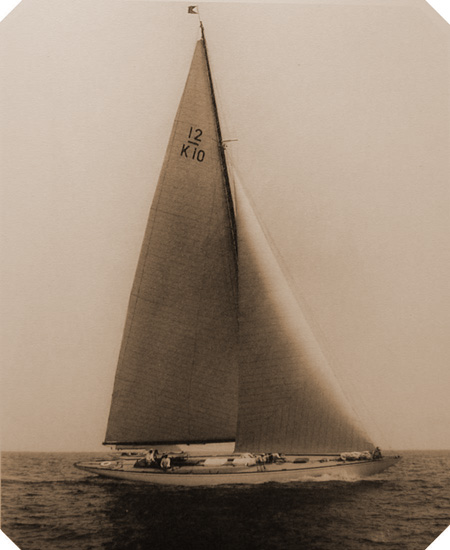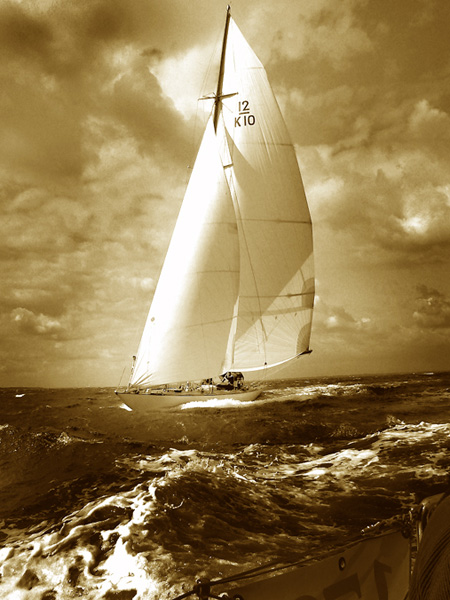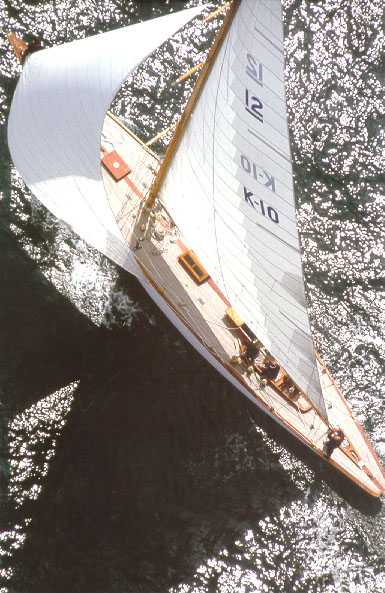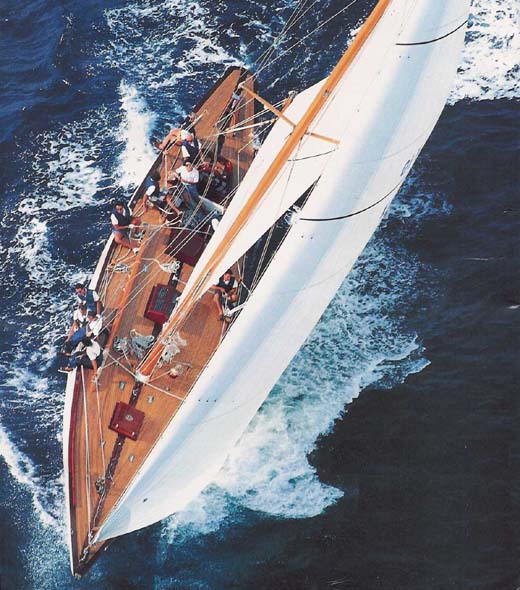
 |
TRIVIA is a classic racing yacht of the 12mR class. These yachts are often referred to as "Twelves" or "12 Metres". The 12mR class rule was defined in 1906 and was used until 1987 to create some of the most competitive racing yachts of their times. The boats are actually not 12 metres in size, but rather between 19 and 22 metres. 12 is the maximum result of a formula, combining Length in the water line, difference of skin girth and chain girth, Freeboard and Sail area:
Between 1958 and 1987 the 12mR class was used for the America's Cup, the oldest and most prestigious trophy in sports. But even before that, the Twelves had been quite popular among the rich and famous owners of racing yachts in the late thirties, especially in Great Britain, Scandinavia, the United States and Germany. TRIVIA was built by Camper & Nicholsons for Mr. Vernon W. MacAndrew in 1937 and in the same year began to compete with the other Twelve metres obtaining excellent results and was classified at first place in her class. In 1938 MacAndrew steered her so successfully that at Cowes Week he won 21 prices, including the King's Cup. In both seasons EVAINE, another Charles Nicholson design, had been a very close second and so YACHTING MONTHLY wrote that "the fight between the two yachts has added a new chapter to English yacht racing, even comparable with those of past history." |
 Trivia 1937 in the Solent © Beken of Cowes |
 Trivia 2003 in the Baltic Sea © Thanos Efthimiadis |
The 1939 season marked a breakthrough for the Twelve metres as the dominant class in international yachting. The leading yacht designers and yards who had previously built the giant J-Class yachts for the America's Cup now turned their focus to the 12 Metre class. William Fife built FLICA II for Hugh Goodson, Alfred Mylne designed JENETTA for Sir William Burton, Charles Nicholson delivered TOMAHAWK to Sir Thomas Sopwith and Olin Stephens designed VIM for Harald S. Vanderbilt. Although it would take two more decades until the America's Cup would continue with Twelves, this season was a first glimpse at what was to come. Especially VIM and FLICA introduced many innovations, such as tank testing, aluminium masts, rudder trim tabs, rod rigging and coffee grinders. Still, TRIVIA and EVAINE held up nicely and even won a number of races again, but VIM clearly dominated the season. It was a change of design generations where William Fife, Alfred Mylne, Johan Anker and Charles Nicholson would have to leave the future to the young Olin Stephens, who would dominate the America's Cup for the upcoming 4 decades. |
After the war, TRIVIA was sold to Charles Ulrick Bay, an American industrialist and U.S. ambassador in Norway, where she sailed from 1948 until 1958 under her new name Norsaga. |

|

|
In 1959 Lord Craigmyle brought TRIVIA back to Cowes and organized the Red Duster Syndicate that planned an America's Cup challenge for 1962. But when Australia entered the America's Cup with GRETEL, the British campaign had to wait until 1964 for another challenge. In 1963 John Arthur Robb modified TRIVIA to be a trial horse for the selections of the 1964 challenger. So in the summer of 1963 TRIVIA returned to Cowes Week and after 25 years again beat the entire British 12 Metre fleet, including
Evaine, Vanity, Sceptre, Flica II and even the new boat Sovereign. In May and June 1964 she entered the official British trials with nineteen runs between Sovereign, Kurrewa, Flica, Sceptre and TRIVIA (as Norsaga). She was then transported to the U.S. to continue her training of Sovereign with the selection trials organised to appoint the challenger between Sovereign and Kurrewa. After the 1964 America's Cup she was sold in the U.S. to Harry J. Ziemann who sailed her on Lake Michigan. |
In 1991 TRIVIA was finally undertaken a complete restoration by the Italian yacht designers Giorgetti & Magrini at Camper & Nicholson in Gosport. The restoration strictly conformed to the original design and construction. All materials and components are identical or similar to what was used in 1937. |
 Trivia 1993 in the Mediterranean |
© Trivia GmbH. For comments & questions please e-mail.